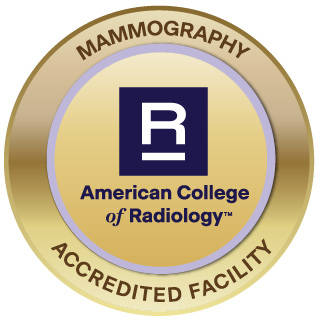
ACR AMERICAN COLLEGE OF RADIOLOGY LOGO MAMMOGRAPHY ACCREDITED FACILITY
Mammography
3D Mammography Video at MCHHS
Accredited Facility
Mitchell County Hospital Health Systems has been awarded a three-year term of accreditation in mammography as the result of a recent review by the American College of Radiology (ACR). Mammography is a special type of imaging test that uses a low-dose X-ray system to examine breasts. A mammography exam, called a mammogram, is used to aid in the early detection and diagnosis of breast diseases in women.The ACR gold seal of accreditation represents the highest level of image quality and patient safety. It is awarded only to facilities meeting ACR Practice Parameters and Technical Standards after a peer-review evaluation by board-certified physicians and medical physicists who are in the field. Image quality, personnel qualifications, adequacy of facility equipment, quality control procedures and quality assurance programs are assessed. The findings are reported to the ACR Committee on Accreditation, which subsequently provides the practice with a comprehensive report that can be used for continuous practice improvement.
What is Full Field Digital Mammography?
Digital mammography uses computers and specially designed detectors to produce an image that can be displayed on a high-resolution computer monitor, and transmitted and stored just like computer files.From a patient's point of view, having a digital mammogram is very much like having a conventional screen-film mammogram. Both film-based and digital mammography use compression and x-rays to create clear images of the inside of the breast. During all mammography exams, the technologist positions the patient to image the breast from different angles and compresses the breast with a paddle to obtain optimal image quality.
Unlike film-based mammography, digital mammograms produce images that appear on the technologist's monitor in a matter of seconds. There is no waiting for film to develop, which can mean a shorter time spent in the breast imaging suite.
The Benefits of Digital Mammography
Unlike other parts of the body, the breast is composed mainly of soft tissue. When breast tissue is x-rayed, it creates an image that looks something like a smoky haze, making it difficult to see tiny "spots," called microcalcifications, and other subtle signs of early cancer.With digital mammography, the radiologist reviews electronic images of the breast, using special high-resolution monitors. The physician can adjust the brightness, change contrast, and zoom in for close ups of specific areas of interest. Being able to manipulate images is one of the main benefits of digital technology.
Another convenience of digital mammography over film-based systems is it can greatly reduce the need for retakes due to over or under exposure. This potentially saves additional time and reduces your exposure to x-rays.
Because they are electronic, digital mammography images can be transmitted quickly across the network. Digital images can also be easily stored, copied without any loss of information, and transmitted and received in a more streamlined manner, eliminating dependence on only one set of "original" films.
Symptoms of breast disease:
●Lump or breast thickening●Swelling or redness
●Nipple discharge
●Breast pain
●Newly inverted nipple
●Scaly appearance to the nipple
●Dimpling or puckering of the skin
Risk Factors of breast disease:
●Risk of breast cancer increases with age●Personal and/or family history breast cancer
●Never had children or had first child after age of 30
●Long menstrual history (periods started early and ended late in life)
What you can do to improve your chances of detecting breast disease and receiving effective treatment by following these guidelines:
●Do a monthly breast self-examination●Have a clinical exam conducted by a healthcare professional each year.
●Have an annual mammogram starting at age of 40.
●See your physician immediately if you notice any of the symptoms of breast disease.
●Discuss your risk of breast disease with your doctor.
Department Director
Darren True, Radiology Director400 W. 8th
Beloit, KS 67420
Phone: 785-738-9553
E-mail: dtrue@mchks.com

